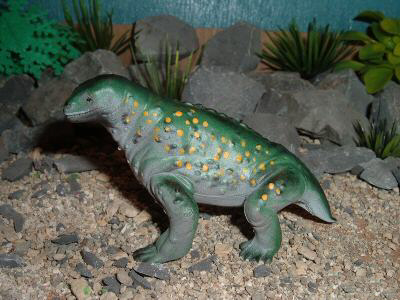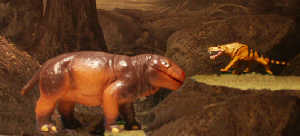
From the Dinosaur Collector
The Late Permian is first modern fauna. Animal life spread out from the equator to temperate zones. The synapsid theraspids evolve from the pelycosaurs of the Early Permian and fill most of the ecological roles. Their descendants will eventually become mammals. Dinocephalians like the giant plant eater Moschops and Estemmenosuchus, dominate the first part of the Late Permian but die out before the great extinction at the end of the period. Gorgonopsians are the major carnivores. The smaller pig and sheep sized dicynodonts a the most common herbivores in this period and into the following Triassic. Anaspids ancestors to the later turtles are less common. They evolve some superficially lizard like forms and giant plant eating pareiasaurs like Scutosaurus that continue until the great extinction. Diaspids the ancestors of the dinosaurs, birds and living reptiles are uncommon. They fill niches as lizard types, gliders and aquatic reptiles. At the end of the Permian is the greatest extinction of all time, 95% of land and sea species die out. The balance of evidence points to an environmental disaster tied to increased carbon caused by the eruption of volcanoes in Siberia. updated 9/15/03
Moschops was a large 17 foot animal. The skull had a heavily built roof that could be a sign that they engaged in head-butting like modern sheep and deer.

Moschops has long pedigree as a toy figure starting with the Marx Toy Company. Above front is a Marx Figure with customized high lights. Original Marx figures were always reproduced in conservative grays, browns and greens. Next to it is a SDC premium from the Sinclair Gasoline set based on the MPC figures, which imitated the Marx figures. While the Marx figure is solid the MPC style figures are hollow underneath. The figure again has been high lighted. The main difference between this figure and the MPC version is the color, MPC figures tended to be in silver, blue, red and green. In back is a Starlux Scutosaurus.

Recast Marx Moschops custom painted by Fred R. Hinojosa.
Estemmenosuchus ("crowned crocodile") was a large, four footed animal about 13 feet long 61/2 feet tall.. This plant-eater had long, sharp, forward-pointing teeth in the front of the mouth and smaller cheek teeth at the sides; these teeth let Estemmenosuchus eat a wide variety of tough plant material (like cycads, horsetails, and conifers). Estemmenosuchus had a massive skull, a short tail, and a bulky body. The thick skull had many bony knobs: two by the nostrils, two in the middle of the snout, and two moose-like "horns" over the eyes, at least one expert on mammal-like reptiles asserts that Estemmenosuchus was a carnivore, exerting great force at the tips of the chisel-like front teeth when slicing the flesh and bones of its prey. Estemmenosuchus may have been warm-blooded with an internal heat engine like mammals.

PlaySchools Definitely Dinosaurs has a toothy Moschops. Hasbro's Jurassic Park Line adds some variety to the Late Permian figures with its articulated Scutosaurus and Estemmenosuchus. The gliding lizard is from the Aurora Swamp diorama model.
One family dominates the top predator role, the
gorgonopsians. Gorogonopsids were lightly built meat eaters with long
running legs, and were a dominant predators that may have hunted in packs.
Lycaenops ('Wolf face) a gorogonopsid had two prominent canine teeth. It seems like
Lycanops and its relatives
were reptilian saber-toothed tigers of the Late Permian.

Hasbro's Jurrasic Park Line Lycanops. The tan original figure at the top center with the baby from the action figure blister card. Below is mutated Lycanops with psychedelic colors.
The Dinocephalian fauna in South Africa is replaced by new groups of big herbivores - the beaked and toothless dicynodonts. These were clearly descended from animals which were common but restricted to small body sizes earlier. Initial diversity of large dicynodonts may have been low, with one genus, Endothiodon, dominating some early local faunas. But within a relatively short period more big dicynodont families and four fully terrestrial big families become common, plus pareiasaurs, the big aquatic herbivores that were the only survivors over 15 kg from the Dinocephalian fauna. Most dicynodonts were characterized by a pair of tusks, Endothiodon was a large example of the tusk less variety. The tusked dicynodonts survived into the following Triassic period.
. 
Endothiodon by Starlux and Lycaenops by Ral Partha.
Return to the Paleozoic

 Click
on the Site A icon left for more diorama listed by location Click on the Site A
icon to the right for Dioramas organized by period or by manufacturer.
Click
on the Site A icon left for more diorama listed by location Click on the Site A
icon to the right for Dioramas organized by period or by manufacturer.